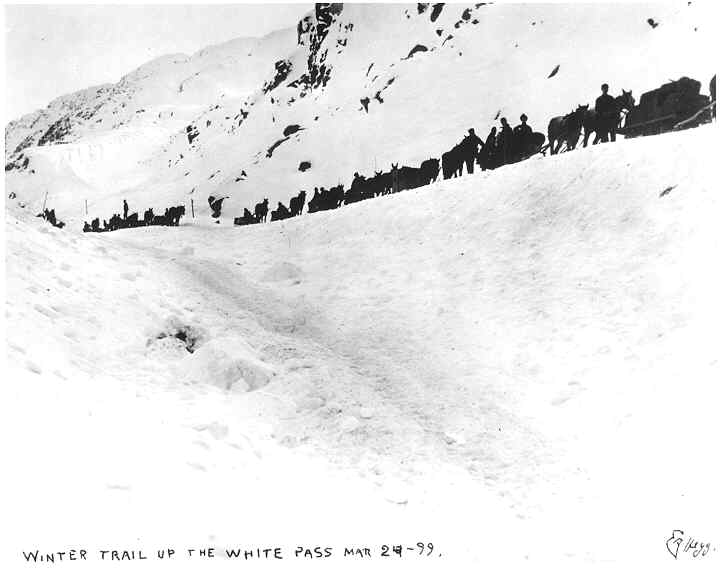
Photo courtesy of Yukon Archives, E.A. Hegg Collection
Publishers were quick to try and profit from the stampede to the Klondike. They produced dozens of maps, handbooks and guides (of wildly varying degrees of reliability) for sale to the thousands of Klondikers beginning to make their way north. The most popular routes were through Dyea and over the Chilkoot Pass or through Skagway and over the White Horse Pass. Among the other routes promoted by various entrepreneurs were the all-water route which passed into the mouth of the Yukon River along the western Alaskan coast, a Canadian overland route that began in Edmonton , and smaller trails to the east and west of the main passes.
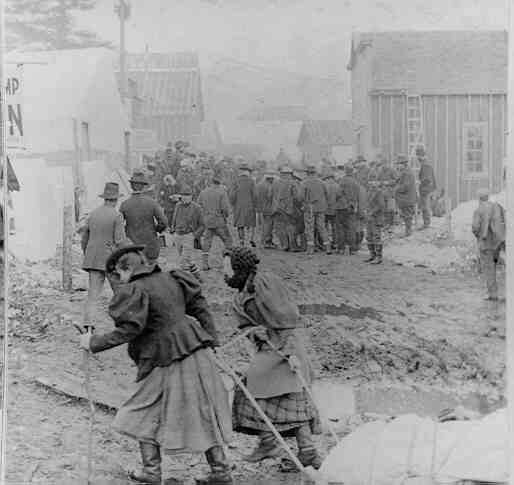
Photo courtesy of David Sundman
Despite the initial confusion, most stampeders crossed over the Dyea and Skagway trails. The two towns competed with each other for stampeders (and their money) by claiming to have the easiest passage into the Klondike.
In truth, neither pass was easy. Winter travel meant thick snow and treacherous ice. In the spring and fall, stampeders, animals, wagons and sleds had to slog along through thick, unending mud. Even those who were fortunate enough to travel during the summer had to pick their way along trails littered with sharp, jagged rocks. After a deadly avalanche killed dozens along the Chilkoot Pass, promoters in Skagway boasted that their trail was proven to be safer.
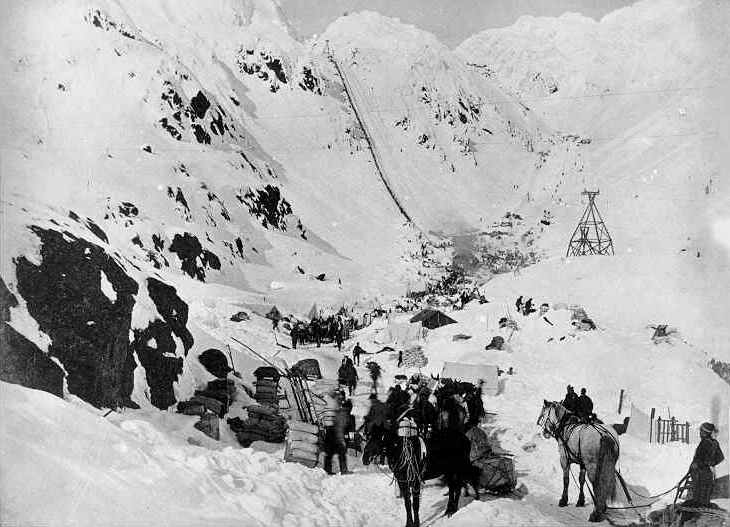
Photo courtesy of the Anchorage Museum of History and Art
The North West Mounted Police were stationed at the summit of both passes. Their assignment was twofold, collecting duty on incoming goods and ensuring that every stampeder was adequately outfitted to survive one year in the Klondike. "Adequate" translated into one ton of goods per person, including food, tents, cooking utensils and tools. When possible, stampeders used animals and sleds to move their goods along the trail. But long portions of both trails were so narrow or in such poor condition that goods had to be carried in 50 to 60-pound packs strapped to the Klondikers' backs. Packs of goods were moved slowly, about five miles at a time.
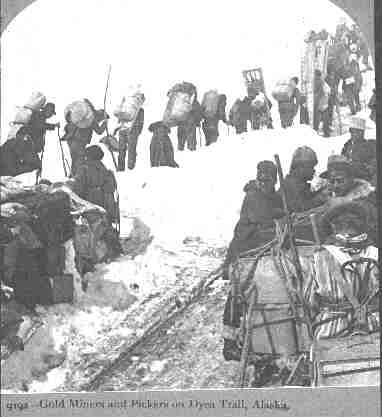
Photo courtesy of David Sundman
After caching the goods by the side of the trail, men and women walked back to their starting place, picked up another pack and headed out again over the same trail. Stampeders walked 80 miles for every single mile they moved their provisions. Those who could afford to do so hired packers and freighters. Most carried or dragged their boxes of evaporated foods, their tents, their frying pans, their shovels, picks, hammers and nails over the passes on their own.
Palmer House, Sheep Camp, April 8, 1898 "My dear friend Mr. Arthur, . . . . I wish you could be here for a day or two just to see the busy scenes on the hills. It is impossible for me to describe them to you. Imagine a narrow trail over the snow, then crowd on it men with sleds, men with packs on their backs, dogs in trains of from two to eight horses, mules and oxen, some drawing sleds and others with packs on their backs. All in an endless procession, going and coming. Now everything going smoothly, then all in confusion when some dogs get tangled up or a horse gets a little out of the trail and floundering up to his belly in the snow. They all toil up the hill. . . . Yesterday I saw two women pulling a sled downhill and the one on the other end of the rope going up. These women have brought their stuff all the way from Dyea unassisted. A great case of pluck, push and perseverance. No one could doubt it who has been on the trail an hour. Women are quite plentiful on the hills and trail, but mostly in company with husbands or some relatives, I think."
Alfred G. McMichael, from a letter describing a scene along the Chilkoot Pass trail. "Klondike Letters: The Correspondence of a Gold Seeker in 1898," edited by Juliette C. Reinicker.
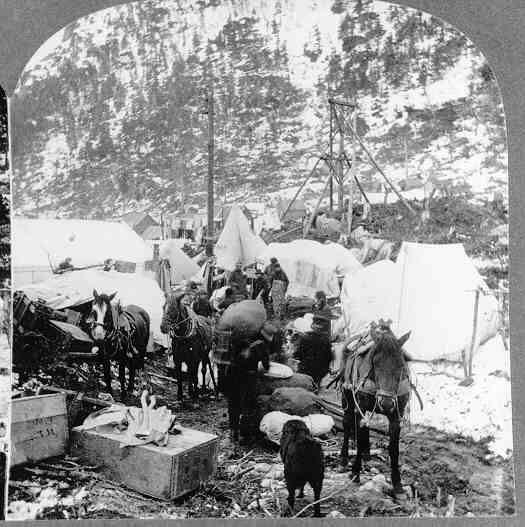
Photo courtesy of David Sundman
The Chilkoot Pass led 32 miles from Dyea to the shores of Lake Lindeman. While most of the trail was not too difficult for walking, Long Hill, the 2 1/2-mile section between Sheep Camp and Scales ascended 1,600 feet, from about 900' to 2500'. Sheep Camp was the last "town" of any substance that the stampeders would see until they reached Lake Bennett. By 1898, Sheep Camp boasted dozens of tents and a few log buildings. Here, restaurants, saloons and hotels lined the trail. Among the accommodations stampeders could choose from if they wished were the Palmer House, the Grand Pacific, and the Seattle Hotel and Restaurant (not to be confused with the Seattle Restaurant on the other end of town).
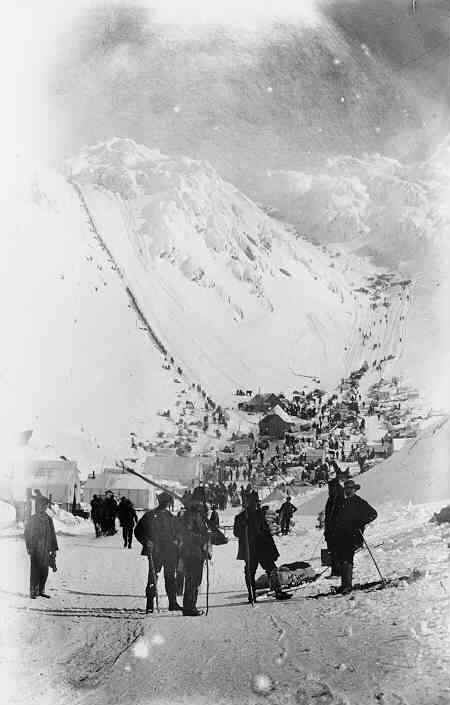
Photo courtesy of David Sundman
The worst part of the trail awaited stampeders after leaving the Scales, a small, ramshackle collection of tents perched on a flat space only a few city blocks square at the base of the "Golden Stairs." The "Golden Stairs" were 1,500 steps carved out of the mountain ice. Stampeders moved up the stairs in a single line, clutching the rope balustrade, carrying their goods on their backs, 50-60 pounds at a time. The term "stampede" was laughable in such crowded, slow-moving conditions. A single trip up the "Golden Stairs" could take as long as six hours.
Thursday, March 31
"The weather has been pretty good today and we have moved our tent to a place lower down, away from the snow. . . . The town of Sheep Camp consists for the most part of tents. The place is so full of people that one can barely breathe. There are many restaurants here, where a meal costs 50 cents. A dozen eggs cost 62 cents."Inga Sjolseth, from a diary she kept along the Chilkoot Pass trail. Courtesy of the Alaska Historical Library
"It is impossible to give one an idea of the slowness with which things are moving. It takes a day to go four or five miles and back; it takes a dollar to do what ten cents would do at home. . . . [Stampeders] have arrived here with outfits and means of transportation; they have thought their expenses ended, but they have only just begun. Where a party has calculated on getting over in days, it is taking weeks. . . . The valley is filled with great water and ice-worn boulders. The trail climbs from one to another of these. . . . The trail enters a cul-de-sac, climbing higher and higher. The valley seems to end; a precipitous wall of gray rock, reaching into the sky, seems to head off farther progress, seaming its jagged contour against the sky—a great barrier, uncompromising, forbidding—the Chilkoot Pass."
Tappan Adney "The Klondike Stampede," 1900

Photo courtesy of Special Collections Division, University of Washington Libraries, E.A. Hegg 98
Going back down was much easier than climbing the "Golden Stairs." A series of slides were carved in the ice near the stairs. Alfred McMichael described the scene in a letter to his family.
"A little farther there were more groves and some as high as one's waist with just room to rush through; not even room to fall over. Then it got so lively we could not keep on our feet and down the mountain we went, the way the children go down the stairs. Away we flew, 'shooting the chutes,' sitting in grooves up to our shoulders at times and other times on the level. Sliding from side to side and slewing from side to side and, oftimes almost turning from end to end; then bumping into the fellow ahead. With the snow in the air and what we kicked up in sliding, we were like snow balls when we reached the bottom. We shot out of the storm into nice weather in a moment, shook ourselves free of as much snow as possible, and our first trip over Chilkoot Pass was ended."
Alfred G. McMichael, from a letter home. "Klondike Letters: The Correspondence of a Gold Seeker in 1898," edited by Juliette C. Reinicker.
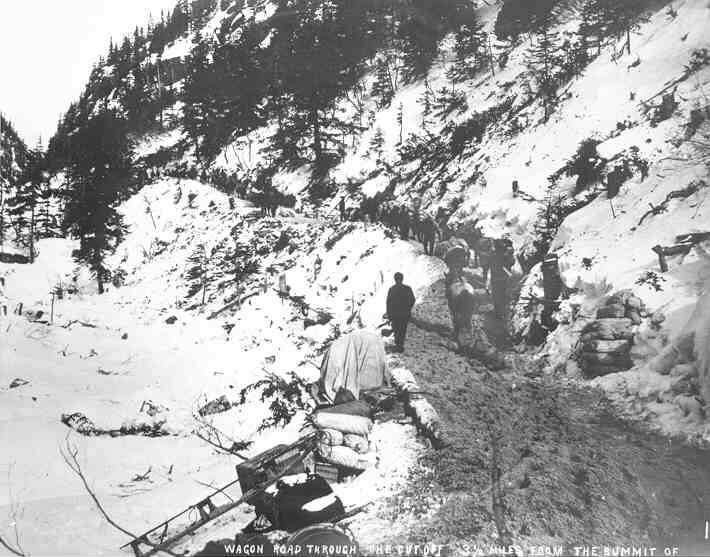
Photo courtesy of Special Collections Division, University of Washington Libraries, E.A. Hegg 194
In contract to the Chilkoot Pass, which had earned the nickname "the meanest 32 miles in the world," the White Pass trail seemed deceptively easy. The first few miles were wide enough for wagons, but as the trail wound through the hills, the pathway narrowed to little more than two feet across. As it rose, the sharp zigzag turns of the trail were boarded on one side by a hill, and dropped hundreds of feet down on the other.
"The path—if, indeed, it can be called one—twists and turns and worms its way from ledge to ledge and between the masses of boulders. Here a tree has been cut down, and we clamber over its stump. There a corduroy bridge lifts one over a brook. Men with stout alpenstocks and with packs painfully struggle upward, stopping now and again for rest. It has been comparatively dry for a day, and the trail is said to be not so bad. . . . Every man we meet tells of the trials of the trail. Anxious and weary are they. I saw one half-way up a hill asleep on his pack, with his closed eyes towards the sky and the rain pattering on his face, which was as pale as death. It gave me a start, until I noticed his deep breathing. A little way on three horses lie dead, two of them half buried in the black quagmire, and the horses step over their bodies, without a look, and painfully struggle on. . . . No one knows how many people there are. We guess five thousand—there may be more—and two thousand head of horses. . . .A steamer arrives and empties several hundred people and tons of goods into the mouth of the trail, and the trail absorbs them as a sponge drinks up water. They are lost amid the gulches and trees."
Tappan Adney, journalist "The Klondike Stampede," 1900

Photo courtesy of the Anchorage Museum of History and Art
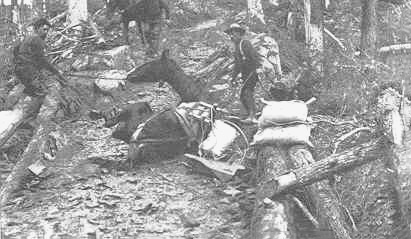
Photo courtesy of the Anchorage Museum of History and Art
The trail out of Skagway had originally been advertised as an all-wagon trail. With such a smooth and easy beginning, people who set out on the trail had little reason to doubt that their mules, oxen and horses could carry their goods all the way over the pass to Lake Bennett. But when the trail narrowed, and there was no room for animals or people to pass, the line bunched together in gridlock.
Many of those using animals to drag heavily laden sleds had never really worked with horses before and treated their animals with harsh brutality. The stampede was fatal for many of the animals as they were beaten and driven along the thin, sloppy trail.
Writer Jack London wrote about the wretched conditions along the trail. In his writings, he noted the nickname stampeders had given that portion of the White Pass trail.

Photo courtesy of Special Collections Division, University of Washington Libraries, Curtis 46112
"Men shot them, worked them to death and when they were gone, went back to the beach and bought more. . . . Their hearts turned to stone - those which did not break - and they became beasts, the men on the Dead Horse Trail."
